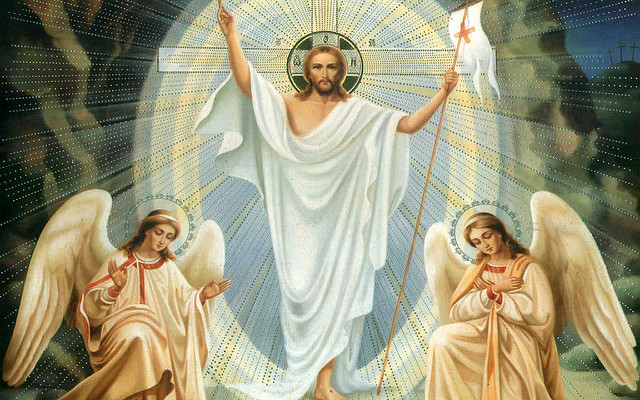Clear Out the Old Yeast
First Reading: Acts 10:34a, 37-43
Responsorial Psalm: Ps 118:1-2, 16-17, 22-23
Second Reading: Col 3:1-4
Gospel: Jn 20:1-9
Reflection from the Anawim Community
Today’s Responsorial Psalm tells us: “This is the day the Lord has made; let us rejoice and be glad!” We rejoice exultantly because on this Day, Christ our Lord, the Paschal Victim who died for us on the Cross, has Risen! Our Easter joy knows no bounds because new life and new hope have been given to us. We know our faith is not baseless because it is built on this solid foundation: the fact that Christ has risen from death (cf. 1 Cor 15:14).
Since Jesus Christ, on whom our faith is based and in whom we put our hope, has risen and is alive forever, we can assert that our entire life has meaning and purpose. It is for this reason that Easter is such a joyous celebration. It is the greatest solemnity of the Church, indeed the Feast of all feasts. The earthly birth of Christ, his life, his preaching, and his miracles all pointed to the great hour of his glorification, which is his Death and Resurrection, the paschal mystery. All God’s gifts now come to us from the Easter mystery, from Christ’s definitive victory over sin and death. The Sacraments of the Church and the life of grace – that is, our real life – flows from the Paschal Victim laying down his life and taking it up that we may have life (cf. Jn 10:18).
Today’s first reading and the Gospel underscore the fact that our faith in the Resurrection of our Lord is grounded on a real, historical fact. The Resurrection of Jesus is not merely the product of anyone’s spiritual imagination. Some theologians who have proposed this error have brought confusion to the minds of many people by suggesting that Christ did not really rise from the dead. But we can trust the Scriptures, the word of God, more than we trust any human being. Jesus Christ himself said that he was going to be killed and that he would rise on the third day. Jesus, who is the Truth, cannot but say what is true.
The witnesses of the Risen Lord – St. John the Evangelist, St. Peter, and St. Paul – confirm to us that they truly encountered him physically and not only in a mystical or spiritual manner. With his usual insightful analysis, Pope Benedict sheds light on the historical reality of our Lord’s Resurrection. He writes that the Risen Lord “appears now as true man and yet as coming from God – as being God himself…. [T]he encounters with the risen Lord are not just interior events or mystical experiences – they are real encounters with the living one who is now embodied in a new way and remains embodied” (Jesus of Nazareth, Holy Week, p. 268).
St. Peter recounts his personal experience of the Risen Lord. He states that Jesus ate and drank with the Apostles after he rose. This does not mean that the Resurrection was a return to normal biological life – for he will never die again. No, the fact that he ate and drank with the witnesses means that the Risen Lord is not a ghost. He does not belong to the realm of the dead; he is alive! Similarly, St. Paul’s experience on the road to Damascus was a real, historical event, an encounter with a living person. It was different from the mystical experience of being “drawn up into the third heaven,” which he recounts in 2 Corinthians 12:1-4 (cf. Jesus of Nazareth p. 273).
While the Resurrection of Jesus is a historical event, at the same time it is an event that transcends history because it ushers us into the reality of God (cf. CCC 647). Jesus Christ, by the power of his Resurrection, dispels gloom and darkness in our lives and imbues us with his own life, joy, and peace here on earth and for all eternity in Heaven. St. Paul exclaimed that there is nothing that can be compared with the supreme advantage of knowing Jesus Christ and the power of his Resurrection (cf. Phil 3:7-11). In today’s reading from Paul’s Letter to the Colossians, he urges us to fix our gaze on “what is above” rather than on “what is on earth.” We now have a new life which is “hidden with Christ in God.”
To attain the fullness of this new life which will be revealed in glory, to gain access to the “supreme advantage of knowing Jesus Christ,” which is the true joy of Easter, Paul encourages us in the reading from his First Letter to the Corinthians to “clear out the old yeast,” “the yeast of malice and wickedness.” In the new life we have received in Christ, we are now “unleavened,” meaning we are freed from the contamination of sin, because of the perfect sacrifice of “our Paschal Lamb, Christ.”
The time of Lent was a grace-filled time for us, during which we prepared ourselves through corporeal and spiritual disciplines to clear out the old yeast so as to celebrate Easter fruitfully. The depth of our Easter joy depends largely on how well we have collaborated with the grace of God to prepare ourselves. While the lessons we learned during Lent remain always valid, today we celebrate their effect on our spiritual life.
Every Eucharistic celebration is essentially an Easter celebration where we encounter Christ our Paschal Victim, sacrificed for our salvation. It makes sense that the Church requires us, following the instruction of St. Paul, to clear out the old yeast of sin. When we are in the state of grace, we can gratefully and profitably receive Holy Communion, in which is contained “the whole spiritual good for the Church, namely Christ himself, our Pasch” (CCC 1324).


